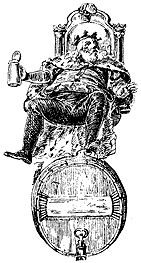Reborn ales of yore, pt. 2
Aimee has a good point. With all the detail I tried to include in my post on the practice of resurrecting ancient beer styles, I neglected to get down to the nitty-gritty - that is, what do these brews actually taste like? What's the point of painstakingly reinventing a beer that tastes like "paintbrush water"? This especially concerns those who're interested in brewing their own versions. It's one thing to find yourself spitting out a sip of something nasty - confronting a 60-gallon barrel of undrinkable funk is a different story.
This especially concerns those who're interested in brewing their own versions. It's one thing to find yourself spitting out a sip of something nasty - confronting a 60-gallon barrel of undrinkable funk is a different story.
Of these styles currently brewed by major labels, you can assume that they take some liberties in adjusting the recipe to suit modern tastes (hence Anchor Steam's use of the term "essayist" instead of "copycat"). I'll just let you draw your own conclusions about how the truly ancient brews must have tasted, considering that they were unboiled (think chunky), unflavored (think blechy), unfiltered (think murky), spontaneously fermented (think sourdough), and had a moldy, bacterial head on them so thick you needed a straw to pierce through to the liquid below. Hey, man -whatever it takes to relax after a long day of hunting and gathering.
Having not tried many of the specific brews I mentioned in the last post (what with my somewhat meager tasting budget), I can only speak on one I've personally had the pleasure of imbibing recently. Alba Scott's pine ale by Brewery Craigmore is a wonderfully rich, flavorful brew. The pine takes the place of the hops, leaving it very sweet and malty, with a woodsy aroma and slightly resinous finish. It's so good, in fact, that I'm keeping an eye out for their other historical oddities - Fraoch heather ale, Grozet gooseberry ale, Ebulum elderberry black ale, Kelpie (ha!) seaweed ale - to see how they compare.
My recommendation, if you're eager to taste something truly primitive, is to try to find beers whose recipes which either omit or greatly restrict the use of hops, as those tend to reflect older styles which pre-date their use in bittering and flavoring. Examples would include the aforementioned pine ale, heather ale, as well as sahti and gotlandsdricka. And I wouldn't suppose that you're going to have as hard a time finding examples of these as it used to be, as the taste for "something different" seems to be providing the market with resurrected styles all the time.
 This especially concerns those who're interested in brewing their own versions. It's one thing to find yourself spitting out a sip of something nasty - confronting a 60-gallon barrel of undrinkable funk is a different story.
This especially concerns those who're interested in brewing their own versions. It's one thing to find yourself spitting out a sip of something nasty - confronting a 60-gallon barrel of undrinkable funk is a different story.Of these styles currently brewed by major labels, you can assume that they take some liberties in adjusting the recipe to suit modern tastes (hence Anchor Steam's use of the term "essayist" instead of "copycat"). I'll just let you draw your own conclusions about how the truly ancient brews must have tasted, considering that they were unboiled (think chunky), unflavored (think blechy), unfiltered (think murky), spontaneously fermented (think sourdough), and had a moldy, bacterial head on them so thick you needed a straw to pierce through to the liquid below. Hey, man -whatever it takes to relax after a long day of hunting and gathering.
Having not tried many of the specific brews I mentioned in the last post (what with my somewhat meager tasting budget), I can only speak on one I've personally had the pleasure of imbibing recently. Alba Scott's pine ale by Brewery Craigmore is a wonderfully rich, flavorful brew. The pine takes the place of the hops, leaving it very sweet and malty, with a woodsy aroma and slightly resinous finish. It's so good, in fact, that I'm keeping an eye out for their other historical oddities - Fraoch heather ale, Grozet gooseberry ale, Ebulum elderberry black ale, Kelpie (ha!) seaweed ale - to see how they compare.
My recommendation, if you're eager to taste something truly primitive, is to try to find beers whose recipes which either omit or greatly restrict the use of hops, as those tend to reflect older styles which pre-date their use in bittering and flavoring. Examples would include the aforementioned pine ale, heather ale, as well as sahti and gotlandsdricka. And I wouldn't suppose that you're going to have as hard a time finding examples of these as it used to be, as the taste for "something different" seems to be providing the market with resurrected styles all the time.



0 Comments:
Post a Comment
<< Home